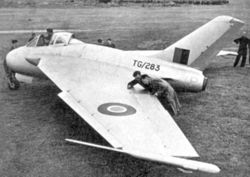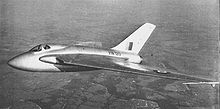De Havilland DH 108 Video - Historical video
|
|
De Havilland DH 108
de Havilland DH 108

Picture - The first DH 108 built - TG283. The torpedo-shaped objects on the wing tips are containers for anti-spin parachutes.
Role: experimental
Manufacturer: de Havilland
Designed by: John Frost
First flight: 15 May 1946
Introduced: Experimental programme only
Status: Cancelled
Primaryuser: Royal Aircraft Establishment
Produced: 1946-1947
Number built: Three
The de Havilland DH 108 "Swallow" was a British experimental aircraft designed by John Carver Meadows Frost in October 1945. The DH 108 featured a tailless, swept wing with a single vertical stabilizer, closely resembling the layout of the wartime German Messerschmitt Me 163 Komet rocket-powered point-defense interceptor. Initially designed to evaluate swept wing handling characteristics at low and high subsonic speeds for the proposed early tailless design of the Comet airliner, three examples of the DH 108 were built to the Air Ministry specifications E.1/45 and E.11/45. With the adoption of a conventional tail for the Comet, the aircraft were used instead to investigate swept wing handling up to supersonic speeds. All three prototypes were lost in fatal crashes.
Design and development
Employing the main fuselage section and engine of the de Havilland Vampire mated to a longer fuselage with a single tail fin and swept wings, the de Havilland DH 108 was proposed in 1944 as a test "mule" for the DH 106 Comet which had initially considered a tailless, swept-wing concept. Despite the Comet design taking on more conventional features, the value of testing the unique configuration to provide basic data for the DH.110 spurred de Havilland to continue development of the DH 108. Selecting two airframes from the English Electric Vampire F 1 production line, the new aircraft had unmistakable similarities to its fighter origins, especially in the original forward fuselage which retained the nose, cockpit and other components of the Vampire. The Ministry of Supply named the DH 108 the "Swallow", a name that was never officially adopted by the company.
The new metal wing incorporating a 43Ëš sweepback was approximately 15% greater in area than the standard Vampire wing. Control was based on the conventional rudder in combination with elevons that were part elevator and ailerons, fitted outboard of the split trailing edge flaps. Although the Vampire fuselage was retained, as development continued, a revised nose and streamlined, reinforced canopy were incorporated.
Testing
The first DH 108 prototype, TG283, utilising the Vampire fuselage and a 43° swept wing, flew on 15 May 1946. Designed to investigate low-speed handling, it was capable of only 280mph (451km/h). De Havilland Chief Test Pilot Geoffrey de Havilland Jr., son of de Havilland company owner-designer Geoffrey de Havilland, gave a display flight in the DH 108 during the 1946 Society of British Aircraft Constructors (SBAC) airshow at Radlett. In later low-speed testing designed to clear the rear fuselage at high angles of attack, the first prototype was fitted with longer Sea Vampire landing gear.
The second, high-speed prototype, TG306, with a 45° swept wing incorporating automatic leading-edge Handley Page slats and powered by a de Havilland Goblin 3 turbojet, flew soon after in June 1946. Modifications to the design included a more streamlined, longer nose and a smaller canopy (framed by a strengthened metal fairing) facilitated by lowering the pilot's seat. While being used to evaluate handling characteristics at high-speed, on 27 September 1946 TG306 suffered a catastrophic structural failure that occurred in a dive from 10,000ft (3,050m) at Mach 0.9 and crashed in the Thames Estuary. The pilot, Geoffrey de Havilland Jr., was killed in the accident. Early wind tunnel testing had pointed to potentially dangerous flight behaviours, but pitch oscillation at high-speed had been unexpected. The subsequent accident investigation centred on a structural failure that occurred as air built up at Mach 0.9, pitching the aircraft into a shock stall that placed tremendous loads on the fuselage and wings. The main spar cracked at the roots with the wings immediately folding backwards.

Picture - VW120 in flight, about 1949
After the loss of the second prototype, VW120 became the third and final prototype based on the newer Vampire F.5 fighter built at Hatfield. It differed from the first test aircraft in that it featured an even more streamlined pointed nose and smaller reinforced canopy (lowering the pilot's seat allowed for a more aerodynamic canopy shape to be employed). Power-boosted elevators had been specified as a means to control the pitch oscillations at the root of the earlier disaster. A more powerful Goblin 4 of 3,738lbf (16.67kN) thrust had the potential to push the DH 108 into the supersonic range. VW120 first flew on 24 July 1947 flown by John Cunningham, the wartime nightfighter ace.
Considered an important testbed for high-speed flight, VW120 was readied for an attempt at the World Speed Record then held by a Gloster Meteor at 616mph (991km/h). The second prototype, TG306, was a "back up" for the attempt before it fatally crashed. On 12 April 1948, VW120 established a new World Air Speed Record of 604.98mph (974.02km/h) on a 62mile (100km) circuit. Then, on 9 September 1948, John Derry is thought to have probably exceeded the speed of sound in a shallow dive from 40,000ft (12,195m) to 30,000ft (9,145m).
In 1949, VW120 put on an aerial display at Farnborough and scored third place in the Society of British Aircraft Constructors Challenge Trophy Air Race before being turned over to the Ministry of Supply and test flown at RAE Farnborough. It was destroyed on 15 February 1950 in a fatal crash near Brickhill, Buckinghamshire, killing its test pilot, Squadron Leader Stuart Muller-Rowland. Accident investigation pointed to a faulty oxygen system that incapacitated the pilot.
Finally, on 1 May 1950 during low-speed sideslip and stall tests the first prototype, TG283, was lost in a crash at Hartley Wintney killing the pilot Sqn Ldr George E.C. Genders AFC DFM, when, after abandoning the aircraft at low altitude in an inverted spin, his parachute failed to open in time. In all, 480 flights had been made by the three Swallows.
Legacy
The DH108 established a number of "firsts" for British aircraft: it was the first British swept-winged jet aircraft and the first British tailless jet aircraft; it was the first British aircraft to exceed Mach 1, one of the first jet-powered aircraft in the world to achieve this landmark speed. The XP-86 (the prototype for the F-86 Sabre) had also broken the sound barrier in a test flight on 26 April 1948. Two of the aircraft which earlier had exceeded the speed of sound, the Bell X-1 and the Douglas Skyrocket, were both rocket-powered.
Operators
United Kingdom
Royal Aircraft Establishment
Specifications (DH 108 VW120: third prototype)
General characteristics
Crew: one, pilot
Length: 26 ft 10 in (8.17 m)
Wingspan: 39 ft 0 in (11.89 m)
Height: 14 ft 0 in (4.27 m)
Wing area: 327.86 ft² (30.47 m²)
Loaded weight: 8,940 lb (4,064 kg)
Powerplant: 1x— de Havilland Goblin-4 turbojet, 3,738 lbf (16.67 kN)
Performance
Maximum speed: 580 kn (677 mph, 1,090 km/h)
Range: 634 nmi (730 mi, 1,175 km)
Service ceiling: 35,425 ft (10,800 m)
Wing loading: 27 lb/ft² (133 kg/m²)
Thrust/weight: 0.42
Related development
de Havilland Vampire
Comparable aircraft
Northrop X-4 Bantam
Messerschmitt Me 163
Bibliography
Bowman, Martin, F-86 Sabre (Combat Legend). London: Airlife, 2004. ISBN 1-84037-411-X.
Davies, R.E.G. and Philip J. Birtles. Comet: The World's First Jet Airliner. McLean, Virginia: Paladwr Press, 1999. ISBN 1-888962-14-3.
Jackson, A.J. De Havilland Aircraft Since 1915. London: Putnam, 1962. No ISBN.
McPhee, Andrew. "Weird Wings - de Havilland DH.108." Unreal Aircraft.. Retrieved: 4 September 2005.
Watkins, David. De Havilland Vampire: The Complete History. Thrupp, Stroud, UK: Budding Books, 1996. ISBN 1-84015-023-8.
Winchester, Jim. Concept Aircraft: Prototypes, X-Planes and Experimental Aircraft. Kent, UK: Grange Books plc., 2005. ISBN 1-84013-309-2.
Living Warbirds: The best warbirds DVD series.
Source: WikiPedia